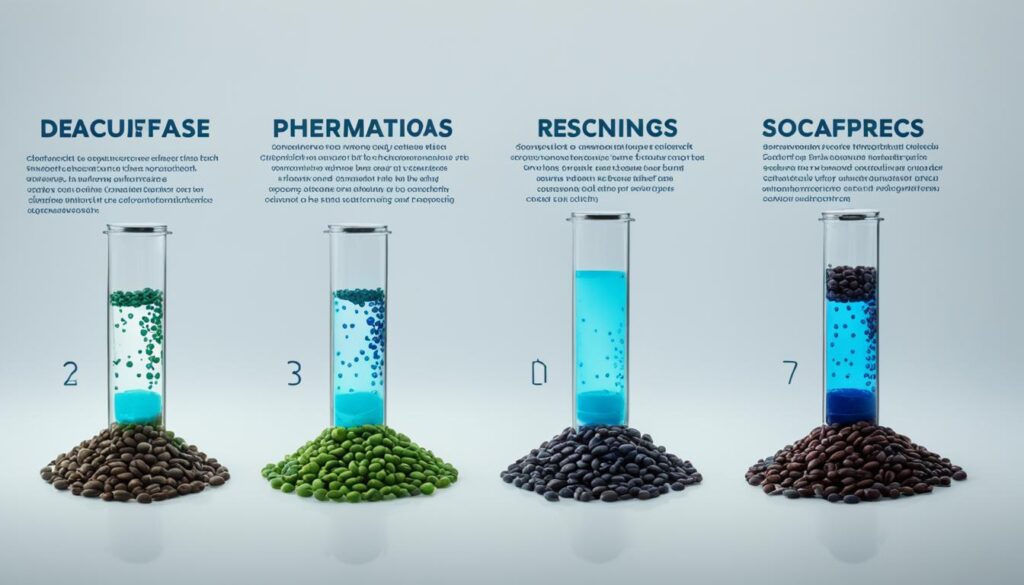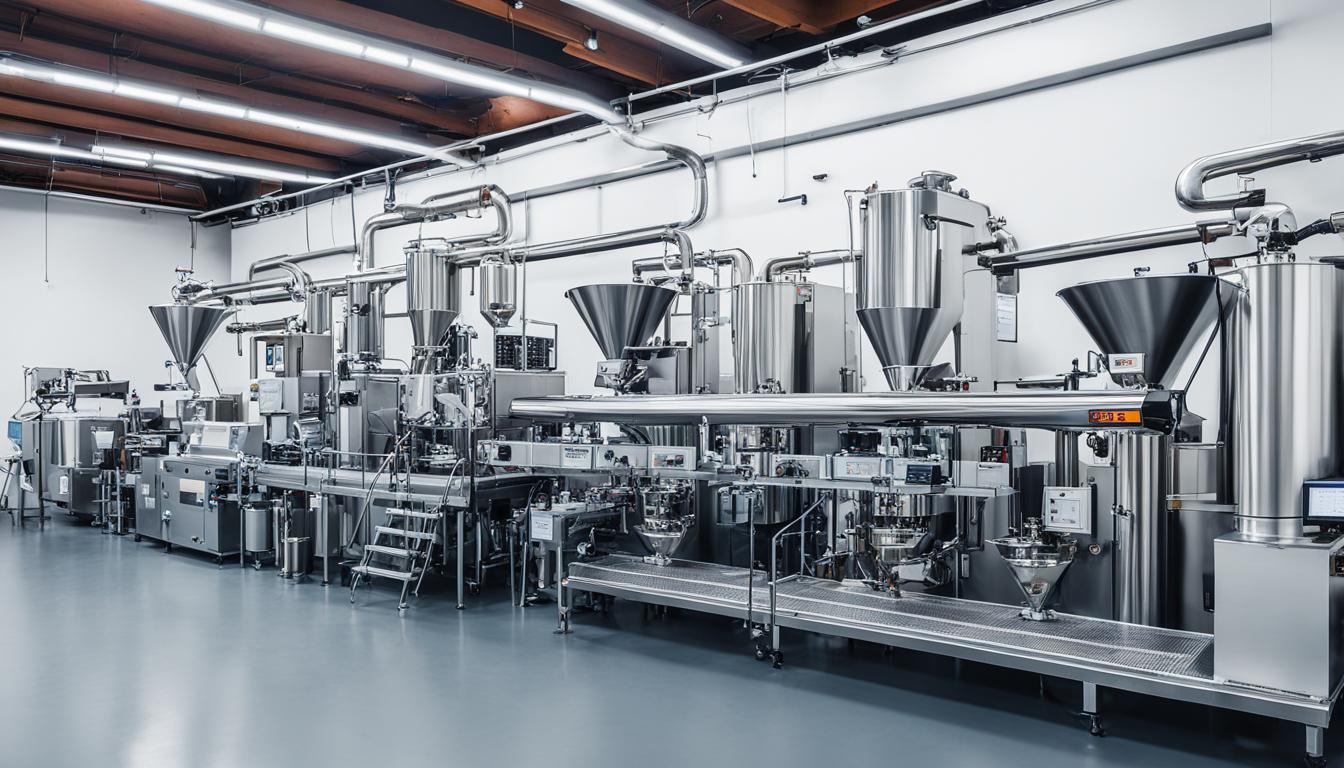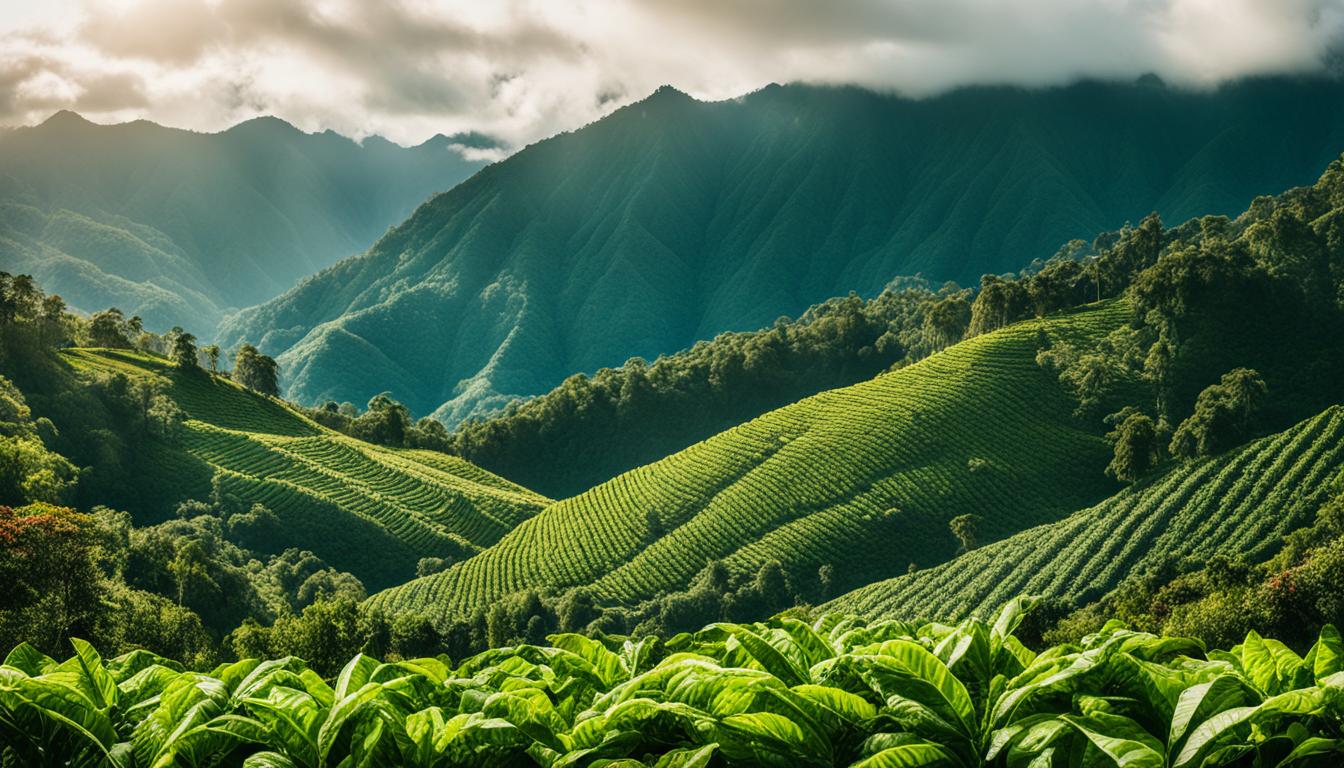Welcome to our article on decaffeinated coffee production. In this guide, we will take you through the fascinating process of how decaffeinated coffee is made, providing insights into various methods and techniques used in the industry.
Decaffeinated coffee has gained popularity over the years, offering coffee lovers the opportunity to enjoy the taste and aroma of their favorite beverage without the stimulating effects of caffeine. Whether you’re sensitive to caffeine, looking to cut back, or simply prefer a decaf option, understanding the production process can enhance your appreciation of this delightful type of coffee.
Key Takeaways
- Decaffeinated coffee is made using various methods, including chemical solvents, natural processes, and innovative techniques like the sugarcane method.
- The decaffeination process aims to remove caffeine while preserving the flavor and aroma of the coffee.
- Chemical solvent methods involve dissolving caffeine from the beans, whereas natural processes utilize water, carbon dioxide, or sugarcane derivatives for caffeine extraction.
- All decaffeination methods are authorized as safe for consumption by food safety regulators worldwide.
- Decaf coffee is associated with numerous health benefits and is a suitable choice for those seeking a reduced caffeine intake.
The History of Decaffeinated Coffee: From Goethe to Roselius
Decaffeinated coffee has a fascinating history that dates back to the efforts of renowned author Johann Wolfgang von Goethe. In his quest to understand why coffee caused sleepless nights, Goethe enlisted the help of chemist Friedlieb Ferdinand Runge. It was Runge who successfully isolated and identified caffeine, paving the way for the development of decaf coffee.
In 1903, a German coffee merchant named Ludwig Roselius made a significant breakthrough in decaffeination. He used benzene as a solvent to remove caffeine from coffee beans, resulting in the creation of the first commercially available decaf coffee. However, due to the later discovery of benzene’s carcinogenic properties, it is no longer used in the decaffeination process.
“The history of decaffeinated coffee is intertwined with the curiosity and innovation of thinkers like Goethe and the ingenuity of individuals like Roselius.”
Today, decaf coffee production has evolved significantly, with multiple methods available for removing caffeine while retaining the flavor and aroma of the coffee beans. From Goethe’s inquiry to Roselius’ pioneering work, the history of decaffeinated coffee is a testament to human curiosity and the quest for a satisfying cup of coffee without the energizing effects of caffeine.
Notable Figures in the History of Decaffeinated Coffee:
- Johann Wolfgang von Goethe
- Friedlieb Ferdinand Runge
- Ludwig Roselius
| Year | Milestone |
|---|---|
| 1772 | Johann Wolfgang von Goethe tasks Friedlieb Ferdinand Runge with studying caffeine |
| 1819 | Runge successfully isolates and identifies caffeine |
| 1903 | Ludwig Roselius uses benzene as a solvent for decaffeination |
Decaffeination Methods: Chemical Solvents and Natural Processes
When it comes to decaffeinating coffee, there are several methods used in the coffee industry. These methods aim to remove caffeine from green coffee beans while preserving the desired flavor and aroma of the coffee. Let’s explore some of the most common decaffeination methods:
Chemical Solvent Methods
One popular decaffeination method involves the use of chemical solvents such as ethyl acetate and methylene chloride. These solvents are applied to the coffee beans to extract the caffeine. The beans are rinsed and dried to remove any remaining solvents, ensuring that the final product is safe for consumption.
Natural Processes
The industry also utilizes natural decaffeination processes that do not involve the use of chemical solvents. One such method is the Swiss Water Process. In this process, green coffee beans are soaked in water to extract the caffeine. The resulting solution, which contains the extracted caffeine and flavor compounds, is passed through activated carbon filters. These filters selectively trap the caffeine while allowing the flavor compounds to pass through. The now decaffeinated beans are then dried and ready for roasting.
Another natural method is the carbon dioxide (CO2) method. In this process, high-pressure liquid carbon dioxide is used to extract the caffeine from the coffee beans. The CO2 is introduced to a high-pressure vessel containing the beans, and as it is pressurized, it transforms into a supercritical state, acting as a solvent to dissolve the caffeine. After the extraction, the CO2 is depressurized, reverting back to a gas and leaving behind caffeine-free beans.
The sugarcane method is another innovative natural process. Ethyl acetate, derived from sugarcane, is used as a solvent to remove caffeine from the green coffee beans. The beans are soaked in a solution of ethyl acetate, which selectively bonds with the caffeine molecules, allowing them to be separated from the beans. The beans are then washed and dried, resulting in decaffeinated coffee.
Each decaffeination method has its own advantages, resulting in decaffeinated coffee with unique flavor profiles. While some methods may be more commonly used than others, the choice ultimately depends on factors such as taste preferences, sustainability, and consumer demand.
| Decaffeination Method | Process | Advantages |
|---|---|---|
| Chemical Solvent Methods | Using solvents like ethyl acetate and methylene chloride to extract caffeine from green coffee beans |
|
| Swiss Water Process | Soaking coffee beans in water and filtering out caffeine with activated carbon |
|
| Carbon Dioxide Method | Using liquid carbon dioxide to extract caffeine from coffee beans under high pressure |
|
| Sugarcane Method | Using ethyl acetate derived from sugarcane as a solvent to remove caffeine |
|
As you can see, the decaffeination methods employed in the coffee industry offer a range of options to produce flavorful decaf coffee. Whether you prefer a chemical solvent method or a natural process like the Swiss Water Process, there’s a decaffeination method to suit every coffee lover’s taste.

The Science of Decaffeinating Coffee: Caffeine Removal and Bean Treatment
Decaffeinating coffee is a delicate process that involves removing caffeine from green coffee beans while preserving their unique flavor and aroma. To achieve this, different methods are employed, including chemical solvents and natural processes.
Chemical Solvent Methods
Chemical solvent methods are commonly used in the decaffeination process. These methods involve dissolving caffeine from the coffee beans using chemical solvents, either directly or indirectly. The two main solvents used are ethyl acetate and methylene chloride. The beans are soaked in these solvents, which extract the caffeine while leaving behind the desired coffee flavors and characteristics. After the caffeine is removed, the beans are thoroughly washed to eliminate any remaining solvent residues.
Chemical solvent methods utilize solvents like ethyl acetate and methylene chloride to dissolve caffeine from the coffee beans, resulting in decaffeinated coffee with preserved flavors.
Natural Processes
Natural decaffeination methods offer an alternative to chemical solvents. These processes are gentler and can be more appealing to consumers who prefer a more natural approach. The two popular natural methods are the Swiss Water Process and the carbon dioxide method.
In the Swiss Water Process, the green coffee beans are soaked in hot water, creating a solution called the “flavor-charged water.” This water contains the desirable flavor compounds of the coffee beans. The solution is then passed through activated carbon filters that selectively remove caffeine, leaving behind the flavor compounds. The beans are discarded, while the flavor-charged water is reused for subsequent batches of decaffeination.
The carbon dioxide method involves exposing the green coffee beans to highly pressurized liquid carbon dioxide. The carbon dioxide acts as a solvent and extracts the caffeine from the beans while maintaining their flavor and aroma. The caffeine-laden carbon dioxide is then passed through an activated charcoal filter to separate the caffeine from the carbon dioxide. The carbon dioxide can be recycled, contributing to the sustainability of this method.
Post-Decaffeination Treatment
After the caffeine removal process, the decaffeinated coffee beans undergo additional treatment to prepare them for brewing. These treatments typically include washing, steaming, and high-temperature roasting. Washing the beans removes any residual solvents or carbon dioxide, ensuring they are safe for consumption. Steaming helps to further remove impurities and stabilize the beans, while high-temperature roasting brings out the desired flavors and aromas.
Visualizing the Decaffeination Methods
| Decaffeination Method | Main Process | Pros | Cons |
|---|---|---|---|
| Chemical Solvent | Dissolving caffeine with solvents |
|
|
| Swiss Water Process | Soaking beans in flavor-charged water |
|
|
| Carbon Dioxide Method | Exposing beans to pressurized liquid carbon dioxide |
|
|
This table provides a comparison of the different decaffeination methods, highlighting their main processes, pros, and cons. It offers insights into the advantages and challenges associated with each method.
Is Decaffeinated Coffee Safe and Healthy?
When it comes to decaffeinated coffee, safety and health are important considerations. Rest assured, decaf coffee is considered safe for consumption.
All decaffeination methods used in the coffee industry are authorized as safe by food safety regulators globally. These methods undergo rigorous testing and scrutiny to ensure the removal of caffeine while maintaining the integrity and quality of the coffee beans.
One of the primary concerns regarding decaf coffee is the remaining caffeine content. Fortunately, the caffeine content in decaf coffee is significantly reduced, with no more than 3% remaining. For individuals who are sensitive to caffeine or looking to reduce their intake, decaf coffee can be a suitable alternative.
Besides being safe, decaffeinated coffee also offers several health benefits. Studies have shown that drinking decaf coffee is associated with increased longevity and a decreased risk of certain cancers and chronic diseases. The wealth of antioxidants and beneficial compounds present in coffee, such as chlorogenic acids and polyphenols, are also found in decaf coffee, contributing to its potential health benefits.
| Health Benefits of Decaf Coffee |
|---|
| Reduced risk of certain cancers, including liver, colorectal, and endometrial cancer |
| Lower risk of chronic conditions, like type 2 diabetes and cardiovascular disease |
| Possible protection against neurodegenerative diseases, such as Alzheimer’s and Parkinson’s |
| Potential anti-inflammatory effects |
| Source of antioxidants and beneficial compounds |
These health benefits make decaf coffee a valuable addition to a balanced and healthy lifestyle. Remember, moderation is key, and individual responses may vary. As always, consulting with a healthcare professional can provide personalized guidance based on your specific health needs.

In the next section, we will delve deeper into the science behind decaffeinating coffee and the specific processes involved.
Conclusion
Decaffeinated coffee production relies on a variety of methods, from chemical solvents to natural processes and even the innovative sugarcane method. Each method shares a common goal: to remove caffeine while preserving the rich flavor and aroma that coffee enthusiasts love. As demand grows for higher-quality decaf options, the industry continues to deliver with a wide range of choices.
Rest assured, decaf coffee is considered safe and healthy for consumption. Regulatory bodies worldwide have approved all decaffeination methods as safe, ensuring your peace of mind when enjoying a cup of decaf. With caffeine content reduced to no more than 3%, decaf coffee allows you to savor the social connections and taste of coffee without the energy boost.
Whether you prefer chemical solvent methods, natural processes like the Swiss Water Process or carbon dioxide method, or the ethyl acetate extracted from sugarcane, there’s a decaf coffee available to suit your palate. So go ahead and explore the world of decaffeinated coffee production, and embrace the delightful experience of a caffeine-free cup of coffee.
FAQ
How is decaffeinated coffee made?
Decaffeinated coffee is made by treating green coffee beans to remove the caffeine while preserving the flavor and aroma. This can be done using chemical solvents or natural processes.
What are the different decaffeination methods used in the coffee industry?
The coffee industry uses various decaffeination methods, including chemical solvents like ethyl acetate and methylene chloride, as well as natural processes such as the Swiss Water Process, carbon dioxide method, and the sugarcane method.
What is the science behind decaffeinating coffee?
Decaffeination involves removing the caffeine from coffee beans while still retaining the desired characteristics of the coffee. This can be done by dissolving the caffeine using chemical solvents or using natural processes like soaking the beans in water or using supercritical carbon dioxide.
Is decaffeinated coffee safe to drink?
Yes, decaffeinated coffee is considered safe for consumption. All decaffeination methods used in the coffee industry are authorized as safe by food safety regulators globally.
What are the health benefits of decaffeinated coffee?
Decaffeinated coffee has been associated with various health benefits, including increased longevity and a decreased risk of certain cancers and chronic diseases. Multiple studies have shown positive health outcomes associated with drinking decaffeinated coffee.




